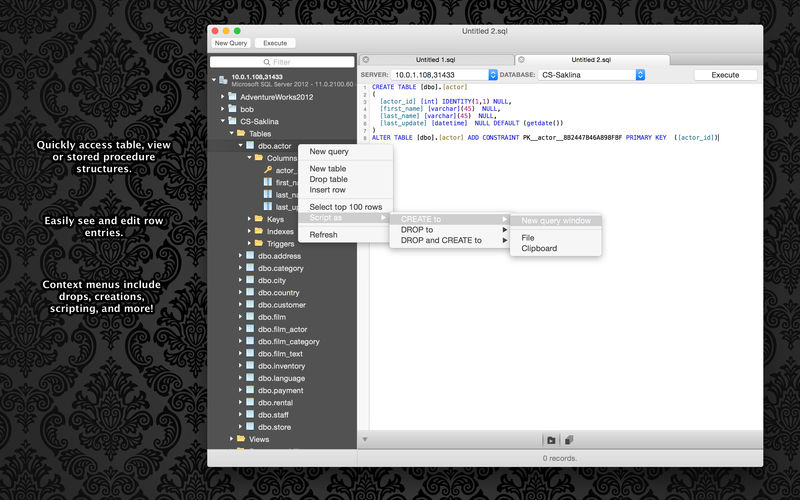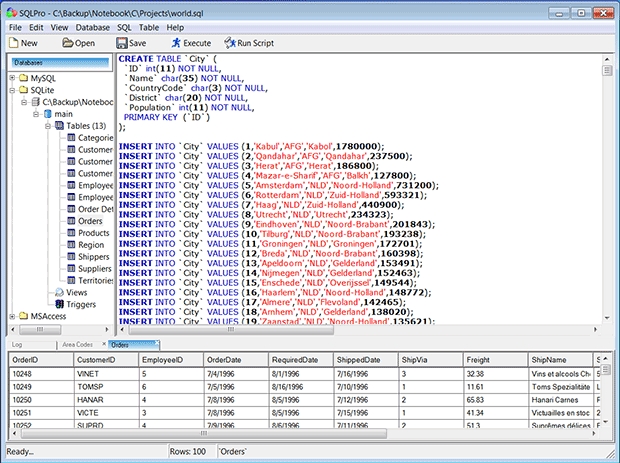

- #CREATE LOCALHOST SQL SERVER ON SQLPRO FOR POSTGRES HOW TO#
- #CREATE LOCALHOST SQL SERVER ON SQLPRO FOR POSTGRES UPDATE#
- #CREATE LOCALHOST SQL SERVER ON SQLPRO FOR POSTGRES SOFTWARE#
- #CREATE LOCALHOST SQL SERVER ON SQLPRO FOR POSTGRES PASSWORD#
- #CREATE LOCALHOST SQL SERVER ON SQLPRO FOR POSTGRES DOWNLOAD#
#CREATE LOCALHOST SQL SERVER ON SQLPRO FOR POSTGRES UPDATE#
Let's create an UPDATE query and make sure it only applies to the requested id with the WHERE clause. This is different than POST, because if we sent our new user request through more than once, it would keep creating new users.įor our API, we're going to set up PUT to be able to handle editing a single user, so we're going to use the :id route parameter this time. PUT is idempotent, meaning you can send the same request through multiple times and only one action will be performed. POST is useful for adding a new user, but we'll want to use PUT to modify an existing user. If you navigate to you'll see the latest entry added to the list. curl -d "name=Dinesh Once you send this request through, you should get a response from the server. We'll run curl -d, followed by a query string containing all the key/value pairs and the request endpoint.
#CREATE LOCALHOST SQL SERVER ON SQLPRO FOR POSTGRES HOW TO#
We'll learn how to set that up by the end of this article, but the fastest and easiest way to send a test POST is with cURL, using the -d (-data) flag. Most of the time when you send a POST request, you're doing it through a web form. Getting API Data From MySQLĬurrently, our routes.js file is manually creating a JSON array of users, which looks like this. Now that we're connecting to MySQL and our settings are complete, we can move on to interacting with the database from the API. You can see the completed database configuration file in our GitHub repo. Create a MySQL poolįinally, we'll export the MySQL pool so the app can use it. Set database connection credentialsįor efficiency, we're going to create a MySQL pool, which allows us to use multiple connections at once instead of having to manually open and close multiple connections. This should refer to the api database we made and use the default localhost settings. Let's create a config object that contains the host, user, password, and database. We'll begin by requiring the mysql module in data/config.js. Earlier, we installed the mysql npm module, and now we're going to use it.Ĭreate a new directory called data and make a config.js file. Connecting to MySQLīack in our app, we have to connect to MySQL from Node.js to begin working with the data. At this point, we have the structure of our table as well as some sample data to work with. VALUES ('Richard Hendricks', Gilfoyle', is no need to input the id field, as it is auto-incrementing. We can also fill the database with the same data that we're currently displaying through a static JSON array by running an INSERT query. Each user will have an auto-incrementing id, a name, and an email address. This SQL query will create the structure of our users table. `id` int(11) unsigned NOT NULL AUTO_INCREMENT, When you have the api database created, move into it and run the following query to create a new table. Make sure MySQL is running, or you won't be able to connect to localhost. In your database viewing software, add a new database and call it api. Once everything is set up here, we can move on to setting up the database for our API.
#CREATE LOCALHOST SQL SERVER ON SQLPRO FOR POSTGRES PASSWORD#
Once you have MySQL downloaded and running, you can use SequelPro or SQLyog to connect to localhost with the username root and password root on port 3306.
#CREATE LOCALHOST SQL SERVER ON SQLPRO FOR POSTGRES DOWNLOAD#
For Mac, download SequelPro, and for Windows download SQLyog.


#CREATE LOCALHOST SQL SERVER ON SQLPRO FOR POSTGRES SOFTWARE#
In addition to setting up MySQL itself, we'll want GUI software to view the database and tables. Once you have this downloaded, open the program and click Start Servers to start MySQL. If you don't have MySQL installed, you can download MAMP for macOS and Windows, which provides a free, local server environment and database. This tutorial will be using MySQL, and if you already have MySQL installed on your computer, you'll be ready to go on to the next step. Up to this point, we have not used a database to store or manipulate any data, so we're going to set one up.

In this tutorial, we're going to set up a MySQL database to store all the data, connect to the database from our Node.js app, and allow the API to use the GET, POST, PUT, and DELETE methods to create a complete API. In the second tutorial, How to Set Up an Express API Server, we learned how to build servers with both Node's built-in http module and the Express framework, and how to route the app we created to different URL endpoints.Ĭurrently, we're using static data to display user information in the form of a JSON feed when the API endpoint is hit with a GET request. In the first tutorial, Understanding RESTful APIs, we learned what the REST architecture is, what HTTP request methods and responses are, and how to understand a RESTful API endpoint. Build a REST API With Node.js and Express: Connecting a Database


 0 kommentar(er)
0 kommentar(er)
